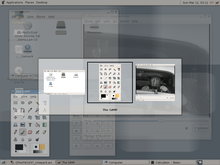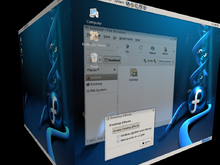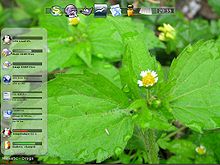Linux Guide/Desktop environments
Jump to navigation
Jump to search
Linux GUIs
[edit | edit source]Desktop environments and window managers are not the same. With X11, a desktop environment includes all the software needed for a desktop, including a window manager, but a window manager only manages the windows and does not include any other software. Sometimes window managers provide extra features, such as a pager. Under Wayland, this is a little different: all of these are called compositors, and are actually a display server implementation, like X server itself. They range in complexity, and will often describe themselves as comparable to window managers or desktop environments.
Desktop environments
[edit | edit source]- GNOME

Many distributions use GNOME as their default desktop enivronment - GNOME (pronounced /ɡəˈnoʊm/) is a desktop environment composed entirely of free and open source software. It is an international project that includes creating software development frameworks, selecting application software for the desktop, and working on the programs which manage application launching, file handling, and window and task management.
- GNOME is part of the GNU Project and can be used with various Unix-like operating systems, most notably those built on top of the Linux kernel and the GNU userland, and as part of the Java Desktop System in Solaris.
- GNOME is also a Wayland compositor.
- See Using GNOME
- Plasma 5

KDE Plasma 5 - Plasma is a free software project by the KDE (pronounced /ˌkeɪdiːˈiː/) community, and is a cross-platform desktop environment designed to run on Linux, Windows and Mac OS X systems. The goal of the project is to provide basic desktop functions and applications for daily needs as well as tools and documentation for developers to write stand-alone applications for the system. In this regard, the KDE project serves as an umbrella project for many standalone applications and smaller projects that are based on KDE technology. KDE software is based on the Qt toolkit. The original GPL version of this toolkit only existed for the X11 platform, but with the release of Qt 4, GPL versions are available for all platforms. This allows KDE software based on Qt 4 to also be distributed to Microsoft Windows and Mac OS X. Currently, Plasma and all of its included software use Qt 5.
- Plasma is also a Wayland compositor.
- See Using KDE
- XFCE

The lightweight XFCE desktop environment - Xfce (pronounced as four individual letters) is a free software desktop environment for Unix and other Unix-like platforms, such as Linux, Solaris and BSD. It aims to be fast and lightweight, while still being visually appealing and easy to use.
- The current version is 4.18. It consists of separately packaged components that together provide the full functionality of the desktop environment, but which can be selected in subsets to create the user's preferred personal working environment. Xfce is mainly used for its ability to run a modern desktop environment on relatively modest hardware.
- It is based on the GTK+ 3 toolkit (the same as GNOME). It uses the Xfwm window manager. Its configuration is entirely mouse-driven, and the configuration files are hidden from the casual user.
- LXDE

LXDE
LXDE is a lightweight X11 desktop environment. However, it is slated to be replaced by LXQt.
Window managers
[edit | edit source]- Compiz

Compiz uses compositing and transparency to achieve attractive and useful effect, like window-switching, shown here. 
Compiz's famous rotating desktop cube. - Compiz is one of the first compositing window managers for the X Window System that uses 3D graphics hardware to create fast compositing desktop effects for window management. The effects, such as a minimization effect and a cube workspace are implemented as loadable plugins. Because it conforms to the Inter-Client Communication Conventions Manual standard, Compiz can substitute for the default Metacity in GNOME or KWin in KDE.
- Compiz plugins include the famous cube effect (example to the right), Alt-Tab application-switching with live previews or icons, and a feature similar to Exposé.
- Enlightenment
- Enlightenment, also known simply as E, is a stacking window manager for the X Window System which can be used alone or in conjunction with a desktop environment such as GNOME or KDE. Enlightenment is often used as a substitute for a full desktop environment.
- One can compile Enlightenment to enable experimental Wayland support.
- FLUXBOX


- Fluxbox is a stacking window manager for the X Window System with the aim to be lightweight. Its user interface has only a taskbar, a pop-up menu accessible by right-clicking on the desktop, and minimal support for graphical icons. All basic configurations are controlled by text files, including the construction of menus and the mapping of keybindings. Fluxbox has high compliance to the Extended Window Manager Hints specification.
- Fluxbox can show some eye candy: colors, gradients, borders, and several other basic appearance attributes can be specified. Recent versions support rounded corners and graphical elements.
- Because of its small memory footprint and quick loading time, Fluxbox is popular in many Live CDs such as Knoppix STD and GParted.
- FVWM

- The F Virtual Window Manager is a virtual window manager for the X Window system. Originally a twm derivative, FVWM has evolved into a powerful and highly configurable environment for UNIX systems.
- IceWM

- IceWM is a stacking window manager for the X Window System graphical infrastructure. It is relatively lightweight in terms of memory and CPU usage, and comes with themes that allow it to imitate the GUI of Windows 95, OS/2, Motif, and other graphical user interfaces. IceWM is meant to excel in look and feel while being lightweight and customizable.
- IceWM can be configured from plain text files stored in a user's home directory, making it easy to customize and copy settings. IceWM has an optional, built-in taskbar with menu, tasks display, network and CPU meters, mail check and configurable clock. Official support for GNOME and KDE menus was previously available as a separate package. In recent IceWM versions, support for them is embedded. External graphical programs for editing configuration and menu exist.









